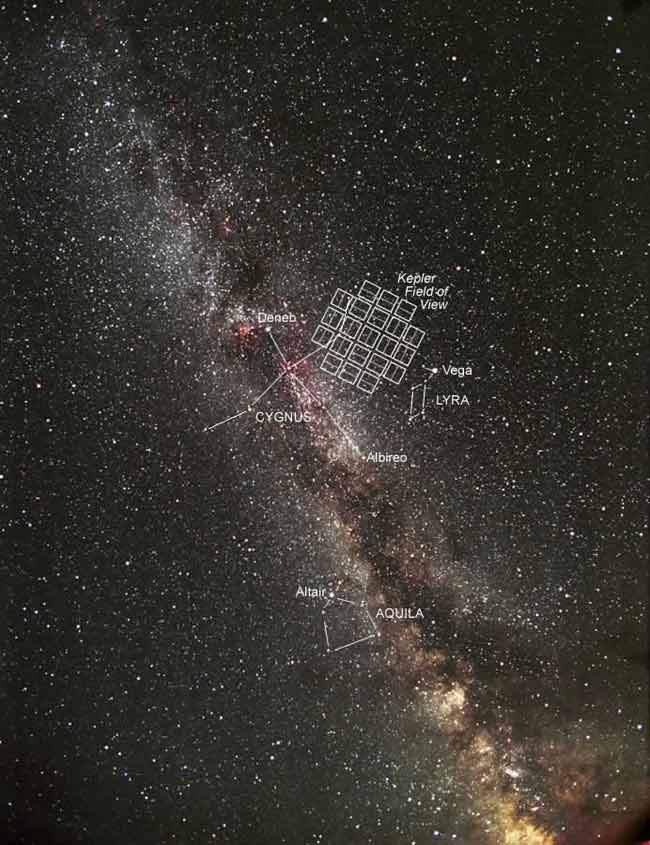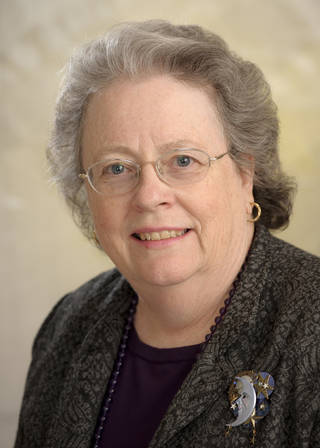The Summer Triangle: Target of Kepler Mission

Each evening, I go outside and look overhead at the Summer Triangle: three bright stars high above my home in California. Then I dream about what will happen when we find another Earth, a habitable planet around a distant sun. In less than a year, the first actual observations to make this dream come true will be underway with NASA's Kepler mission.
Kepler is NASA's first mission capable of finding Earth-size and smaller planets in the habitable zone of distant stars. The Kepler mission team expects to discover hundreds of planets orbiting other stars. Some of those will be in the habitable zone of their parent stars where water is liquid on the surface of the planet(s). To find the small, Earth-size planets, the mission will continuously monitor 100,000 stars for periodic decreases in stellar brightness caused by planets transiting their stars. Transits happen when a planet crosses its star as viewed from our solar system. The transits last for a few hours to about a day.
Using precise photometry (brightness measurement), the Kepler spacecraft will detect the small decreases in light as a planet transits its star. Three transits with a consistent period, brightness change, and duration provide a rigorous method for detection of extrasolar planets. Planets the size of Earth and even smaller can be found this way, but this requires that we go to space where the high-precision (1 part in 20,000) measurements can be made. On the ground, such precision is denied by atmospheric blurring.
So, where will Kepler look and how long will it stare to find Earth-size planets?
The science team chose a large field of stars in the Summer Triangle, an asterism composed of Deneb, Vega and Altair. These three first magnitude stars are easily seen in northern skies from spring until fall. The field is near, but not in the Milky Way where the star density is higher and could cause confusion. It's above the plane of our solar system, away from the co-planar asteroids and dust. It's easily visible to northern hemisphere observatories that can make follow-up spectroscopic observations of stars that may have planets. Finally, the field is easy for everyone to find as it's centered between Deneb and Vega. Download a planisphere (rotating star map) marked with the Kepler field of view (FOV) and stars known to have host planets.
The FOV was selected to sample a portion of the Milky Way galaxy that is populated with stars similar to our Sun in size and age. The FOV encompasses millions of stars and distant galaxies, and from those, about 100,000 stars will be selected for observation. Statistically, a small percentage of the 100,000 star systems will be lined up so that we can discover their planets in transit. Kepler has to stare at a large number of stars to find those with transiting planets.
Compared with other telescopes, Kepler has a very large FOV. The heart of the Kepler telescope detector system is an array of 21 CCD pairs. Each CCD pair covers 5 square degrees on the sky; the array collects starlight from over 100 square degrees of sky. (The pairs are spaced so that light from the brightest stars will fall between the detectors because the bright stars would overload the system.) Overall, the CCD array spans more than half the way between Deneb and Vega. At arm's length, your two hands (side by side, with your index fingers touching) span the FOV. In contrast, the FOV of most deep-space telescopes is akin to looking through a tiny straw — like a coffee stirrer. Kepler will search a big piece of the sky and sample a large population of stars to find habitable worlds.
Breaking space news, the latest updates on rocket launches, skywatching events and more!
When you look at the Summer Triangle some evening soon, think about what we might discover with the Kepler mission: another place like Earth. This space mission should be able to answer a fundamental question: Are planets like Earth rare or common?
Tell us what you think about finding other worlds.
The Kepler mission invites you to participate in our "Names in Space" project where you can submit your opinion (up to 500 words) plus your name, city, state and country. Your information will be recorded on a DVD, attached to the Kepler spacecraft, and launched. A copy of the DVD will be provided to the Smithsonian Air and Space Museum as an historic document of public opinion about the Kepler mission's search for other Earths. (The project will remain open until November 1, 2008.)
- Video: Planet Hunter
- Top 10 Most Intriguing Extrasolar Planets
- The Kepler Mission: The Search for Earth-like Planets

Edna DeVore is a science and astronomy educator and the former Director of Education and Public Outreach for the SETI Institute. She earned an undergraduate degree from the University of Pacific followed by a master's degree in instructional technology from San Jose State and a master's in astronomy from the University of Arizona. In 1992, Edna joined the SETI Institute, where she wrote features on space exploration, astrobiology and more, some of which appeared on Space.com. She was among the first principal investigators to propose projects to NASA's Office of Space Science and receive funding for educational programs. Edna went on to work on education and public outreach for NASA's Kepler space telescope and SOFIA flying telescope missions. Edna received numerous awards during her tenure at SETI, including NASA Honor Awards for her work on Kepler and SOFIA, and Aerospace Awareness Award for Women in Aerospace in 2005. Edna retired in 2013.
